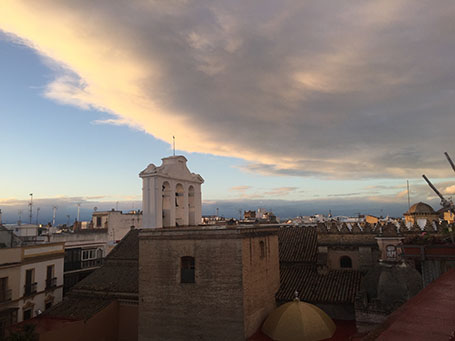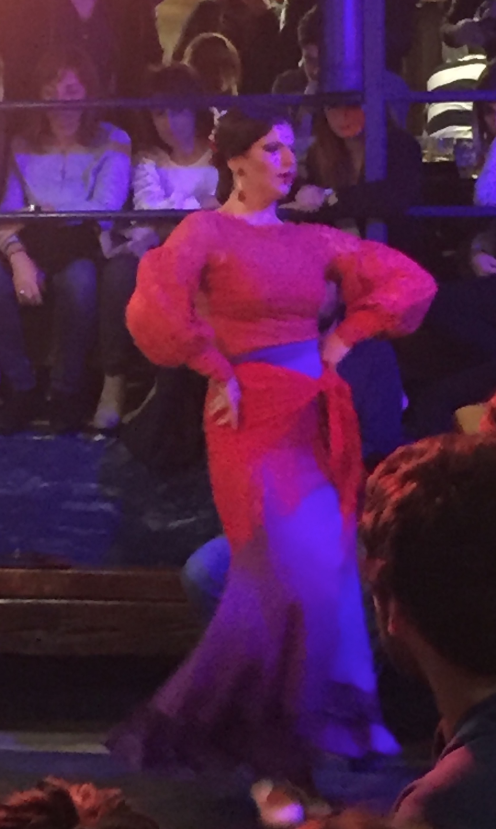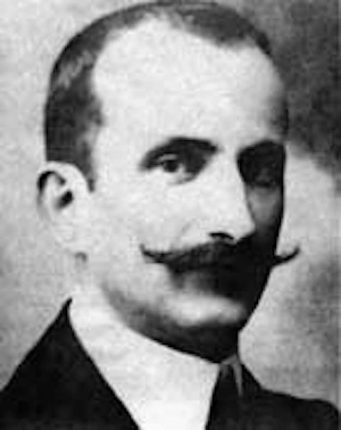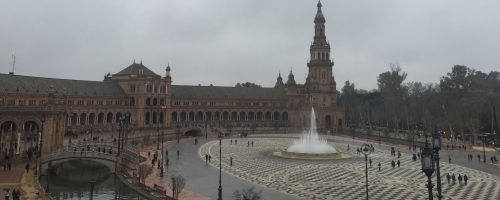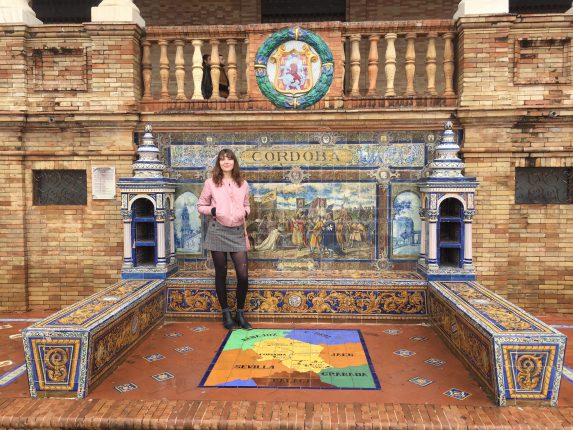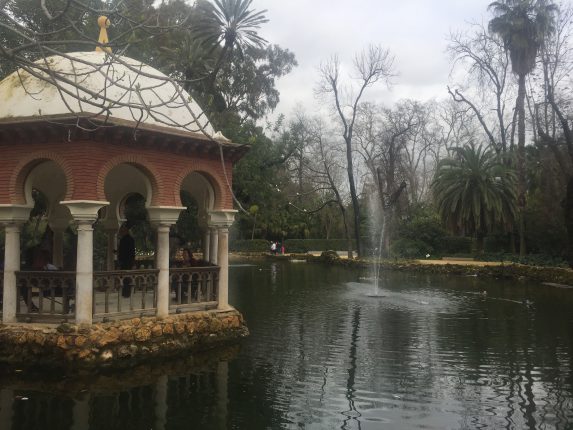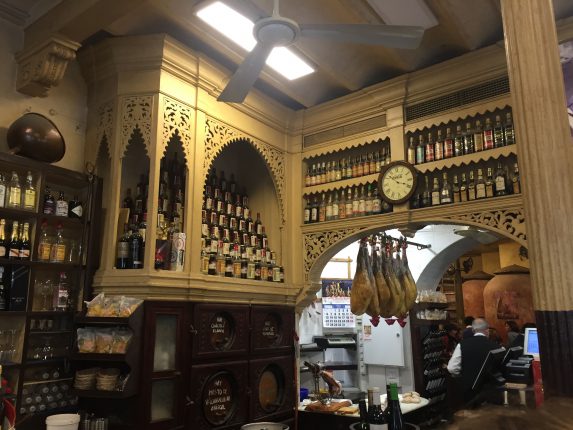by Celia Cody-Carrese
A Very Spanish Weekend: Sevilla
Animated chatter morphs into hushed murmurs as the staff pushes out a hearty “shhh” across the room. It’s starting. Sevillanos and tourists alike are still searching forany bit of open space where they can sit and watch the show. The guitar starts, before the room gets quiet enough to hear it clearly. Next comes the clapping, soft and quiet at first. The singer lets out a long, high cry, his voice weaving in and out of the handclaps and guitar. There is pain and passion in his voice, that hooks into your ears and won’t let go. Seated next to him is the dancer, a woman wearing a red top, long purple ruffled skirt, and a red scarf tied around her waist. Her lips are red and she wears red and white flowers in her hair, parted down the middle and worn in a low bun. She is the picture of flamenco. Her white shoes begin to tap on the floor, along with the rhythm of the hand claps. Something beyond my understanding occurs which signals her to stand and take her spot in the center of the small wooden tablon, or stage, laid out on the floor. Maybe it’s a line in the song, or maybe it was just the feeling of the moment.She is larger than life – her feet strike the floor at a speed that seems inhuman, her arms twist and sweep across her body, her hips ground all her movements. But her face, her face is what says it all. She doesn’t ever flash us a dancer’s smile –instead,her face shows the effort behind everything. The pain and joy of the music, the sheer difficulty of what she is doing. By the end of the second song, a sheen of sweat covers her face. She’s not here to look pretty. She’s here to emote, to dance, and to do something really difficult, really well. This is true for the guitarist and singer as well–they don’t put up a front, it’s just raw emotion and effort. And that’s what made my first time seeing flamenco so incredible.
Sevilla is the capital of Andalucía, and maybe rightfully so (but don’t tell anyone in Córdoba I said that!). It’s home to some of the best flamenco, best gastronomy, and biggest displays of Spanish architecture. My favorite place in Sevilla is the Plaza de España, a grandiose building and plaza designed by Sevillan architect Aníbal González Álvarez-Ossorio, constructed for the Iberian-American Exposition in 1929.Walking up to the Plaza is pretty breathtaking there are so many elements and details that I couldn’t decide what to look at first.
The Plaza de España is made up of a huge plaza, obviously, and an equally huge building that curves around the outside of the Plaza. Along the front of the building are murals made of intricate hand painted tiles, which represent different cities and regions in Spain.Within the plaza is a moat-like body of water, where ducks floating between rowboats. Over the water are four bridges, featuring brightly painted balustrades (theside part of the bridge). The whole thing is pretty stunning. We spent about an hour just walking around and staring at everything, and then rented row boats for half an hour. Fun fact! The Plaza de España was used as a set in Attack of the Clones, the second film in the Star Wars prequels. Anakin and Padmé can be seen walking through the Plaza, which in the film is on the Planet Naboo.
Next to the Plaza de España is another impressive display of something Spain does really well-parks.Walking through the Maria Luisa park takes you through tropical landscaping, beautiful fountains, and ponds filled with birds, including two large andfriendly swans. (Feed them grass, they won’t bite!) Scattered throughout the park are various structures, including a dome topped gazebo and a beautiful building which houses the Museum of Arts and Traditions. Every corner holds something different, and simultaneously the whole park fits together beautifully. It’s historical, lush, and whimsical.
What’s a weekend in Spain without delicious food? Sevilla is home to a lot of great restaurants, and in total has over 3,000 tapas bars and restaurants! 3,000! My favorite place we went to was an old bar called Casa Morales, complete with giant barrels of vino and huge legs of jamón hanging over the bar. I don’t eat meat and the pig legs kind of weird me out, but they also feel so Spanish! I had espinacas Andaluz stew of spinach and garbanzo beans served with bread. It was delicious and so filling for only a small tapa! We also had amazing gelato right next to the Cathedral -my flavors included basil-lime, coconut, and almond.We sat in the plaza enjoying our gelato, watching horse drawn carriages pass by. Nearby a young woman warmed up for a street performance, where she danced hip hop and contemporary.
Something I have grown to love about Spain is the street performers. Many cities I have been to, including cities in America, have some pretty hokey street performers. Often they are talented, but there is too much schtick thrown on top of whatever art form they are doing. However, in Spain the street performers are a bit humbler and more original. In Madrid I saw roller skaters dance like they were on ice and jump over a row of about 8 people lying on the ground. In Córdo bayou can often see a man who plays saxophone on thePuente Romano, as well as various guitarists in the center. In Toledo outside a church, flamenco rhythms from a man’s guitar softly filled the air. The young dancer we saw in Sevilla left out candies in a box next to the hat she used to collect donations. Other notable sights in Sevilla include the Real Alcazar, a palace complex with Mudéjar (Moorish), Renaissance, and Baroque architectural styles.Within the Alcazar rare beautiful and extensive gardens,which a raised, covered walkway runs along.The Alcazar, along with the Plaza de España, are still in use today for royal and government purposes, respectively. And as with any Andalucían city, meandering throughout the narrow and winding streets is never a waste of the afternoon.

Sevilla truly has a place in my heart, along with every other beautiful place I have been able to see during my time here in España!
